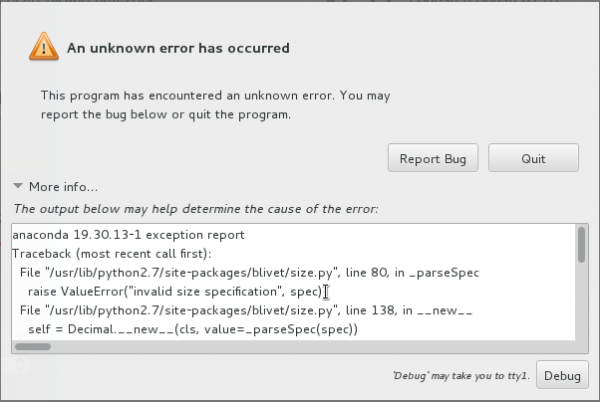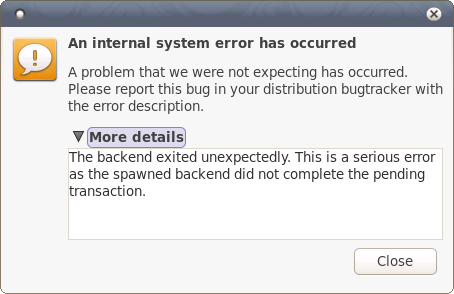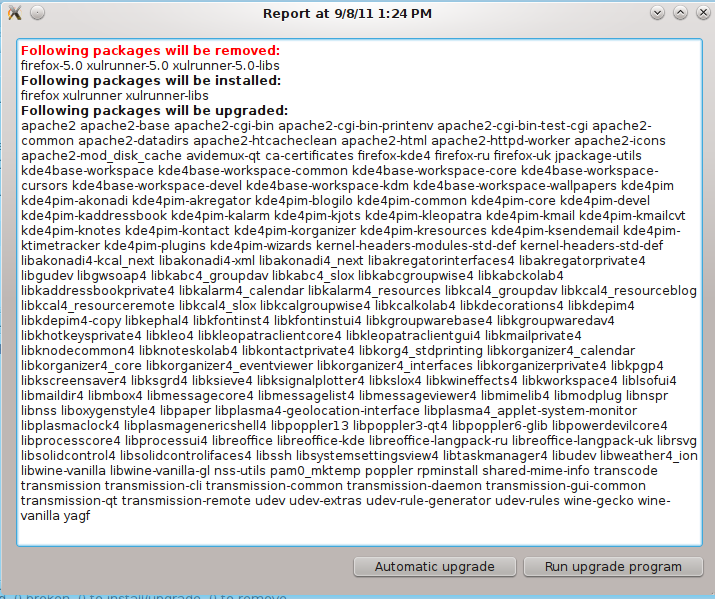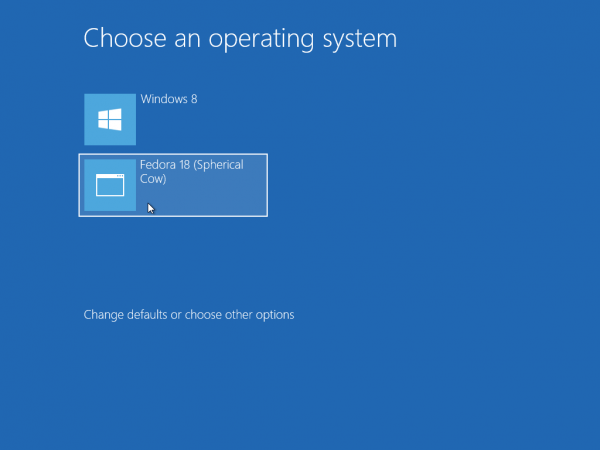8. KDE Spin: I’m writing this review from a yet-to-be-upgraded installation of Fedora 18 KDE. Other than having to replace the Kickoff menu, which is the default menu on almost all KDE desktops, with the Lancelot menu, and installing Rhythmbox in place of Amarok, the native music application for KDE, it (mostly) has been a trouble-free experience. The KDE desktop is that much more mature and more suitable for how I interact with a desktop computer than a default installation of a GNOME 3 desktop, though the latest GNOME 3 updates have been slowly moving in the right direction.
A question I always ask myself whenever I install a Fedora KDE edition is this: Why is Konqueror the default Web browser? I’ve written about this before and it bears repeating here. Konqueror is a powerful application, supporting more protocols than any other (Web browser). but as a dedicated Web browser, it’s terrible. So the first thing I always do, after logging into a new Fedora KDE desktop, is install Firefox, which just happens to be the default Web browser in the main Fedora edition.
Here is a screen shot of the KDE desktop, showing the context menu of the firewall-applet, the same applet that would not start in the GNOME 3 desktop.

And here is the same desktop showing the default menu. Not my favorite menu, so the other thing I do, after installing Firefox, is to replace it.

One of the better replacements available, is the Lancelot menu. On a test installation of Fedora 18 KDE, I’ve even tried the SimpleWelcome menu of ROSA Desktop, though I’ve not tried it on any test installation of Fedora 19 KDE (see Install ROSA Launcher on Fedora 18 KDE).

Just one more screen shot of the desktop showing an experimental feature of the Lancelot menu.

For power-users, holding down the Alt and F2 brings up a very useful utility of the KDE desktop. From this small app that pops up, you can search for local content, online content by specifying “gg” (that’s short for Google), though the Youtube and Wikipedia plugins don’t seem to work, because I could not get results by typing in a search term I now can only be returned from the Internet.

ROSA Desktop KDE, because of a couple of applications created by ROSA developers, has more user-friendly features than the KDE edition of other distributions. Those enhancements, represented in graphical form as StackFolder and KLook, have not been integrated upstream because of some disagreement between KDE and ROSA developers.
StackFolder and KLook make the ROSA desktop seem more vibrant than other KDE desktops. They are the type of features we should be encouraging other distro developers to integrate into their distributions. These are Free Software, so there’s no barrier to adoption. If I were a Fedora developer, I’d make integrating StackFolder and KLook into Fedora 20 or 21 a top priority. If you are interested, you may read the exchange between ROSA developers responsible for KLook and StackFolder and KDE developers here. You may also read the message from a ROSA developer introducing both utilities to KDE developers.
9. Graphical Package Manager(s): On Linux distributions that publish installation images for multiple desktop environments, I find that certain system management applications are the same across the different desktop environments. In Linux Mint and ROSA Desktop, for example, the different flavors or editions that they publish share the same graphical package manager. So the user experience, when it comes to managing applications, is the same, regardless of the desktop environment in use. That is not the case on Fedora, where the main edition and the KDE Spin feature different graphical interfaces for managing applications. I think even the Xfce Spin uses a different graphical package manager called Yum Extender.
In the main edition, the graphical package manager is called the gpk-application, and Apper in the KDE Spin. Compared to the Software Manager of Linux Mint, Deepin Software Center (DSC) of Linux Deepin, and even the Software Center of Ubuntu, both look dated, even though they are still being actively developed. Below is a screen shot of the gpk-applications

And this is of Apper.

Performing a search for applications from either graphical package manager can often be slow and return results that are not very specific to the search string. That’s why I prefer searching for applications from the command-line using the yum command.
Talking about yum, you now have an extra option when attempting to install an application. Before Fedora 19, you were prompted by yum to type a “y” or “N” to indicate your willingness to install or abort the installation of an application. The new option now lets you download the application or applications for installation at a later time. That option is the “d” shown in this image.

10. To sum, every new edition or release of Fedora tends to have more newer features than other distributions, but those features also tend to be of the enterprise-grade, rather than for desktop users. And because my focus is on desktop distributions, I’ve tended to write about those features that impact desktop users the most.
That’s why I’m especially happy with the firewall-applet and its backend application, and with the automatic bug reporting tool. These are desktop-centric and user-friendly applications. It would also be good if there’s some consistency across the various editions of a Fedora release, not just in management applications, but also in software installation.
For example, in the KDE Spin, there are three games installed. Compared to other distributions, that’s like a bad joke, but that’s three more than are installed in the GNOME 3 edition. So like the Linux Mint developers, it seems that whoever is responsible for rolling the main edition of Fedora 19 has a grudge against games, even though playing games is one of the top two activities on the Web (guess what the other one is)
Regarding consistency in management applications, especially with respects to the graphical package manager, I think the time is ripe for the Fedora team to give users the same experience across the different Spins and the main edition. And it might just be better to port an existing one than to code one from scratch. None of the ones I have in mind are perfect, but the best candidate is Linux Deepin’s DSC.
11. Resources: You may download 32- and 64-bit installation ISO images of the GNOME edition, for the Spins and Cloud images here.








Cinnamon… my problems with Gnome are now solved.
FedUp tool was introduced since Fedora 18 to upgrade your system, but it will work with Fedora 17. For fedora 16 and older verions, to upgrade fedora to newer verion, we used “Preupgrade”
Before you do anything, **backup** your important data first to external hard drive, usb disk or to any another machine.
# yum install fedup -y
# yum update
# reboot
After your system rebooted, run
# fedup-cli –reboot –network 19
source: http://namhuy.net/1358/upgrade-fedora-18-to-19.html
“2. Automatic bug reporting tool”
This isn’t new in F19, not remotely – we’ve had automated crash submission from the installer since, man, I think at least since F12 when I started on Fedora.
“In the KDE Spin, you can change the firewall zone for an interface from the NetworkManager setting. That is not possible from the NetworkManager window of the GNOME Shell.”
Yes, it is. Select the connection, hit the ‘properties’ button (that cog icon at bottom right), click Identity, there’s a ‘Firewall Zone’ drop-down right there.
“So given that the third attempt was successful, I can say with some degree of confidence that Anaconda has a nasty but at the step of the installation process shown in the image below.”
That’s odd: I haven’t seen a single crash there and I’ve run thousands of F19 installs. But then, I don’t use the resize function much (personally I’d rather resize a partition prior to an installation attempt; partition resizing is just a finicky thing to deal with). Perhaps it can crash if you happen to try and set the root password while the resize operation is in place? I’m not sure why that would happen, but it’s all I can think of. It would certainly help if you’d file bug reports for the crashes: we have no chance of fixing them without reports (containing all that data the bug reporting tool provided).
“Though Anaconda has most or all advanced features in place, a few basic ones, like being able to specify a bootloader password and install the bootloader to a location other than the Master Boot Record (MBR), is not in place.”
The second is an intentional choice, not a ‘missing feature’: https://bugzilla.redhat.com/show_bug.cgi?id=872826 . The first is possible via kickstart, I don’t know if it’s intentional or an oversight that it is not available through the GUI.
“One thing I fail to understand about the GNOME Shell, is why the Suspend option is not in the User Menu or why it’s not listed in the shutdown options window. Instead, the developers decided that the place location for it is on the login screen. So if you are logged into the system and wish to put the computer in Suspend mode, you have to first logout of the system. Bad implementation!”
Hold down alt, and Power Off turns into Suspend. If you recall, back around 3.0 – 3.4, there was no Power Off option, only Suspend, and people bitched so much about that it was changed: you could hold down alt to turn Suspend into Power Off. I think in 3.6 it was flipped so it’s Power Off by default and you hold alt to turn it into Suspend.
“I’m not a big user of keyboard shortcuts, which means that to get to the Frequent-ly used application picker view of the GNOME Shell requires two mouse clicks.”
I really, _really_ don’t get why people don’t just use the ‘press start key, type name of thing you want to launch’ method. It is the way the Shell’s designed to work and by far the easiest way to launch anything.
“Fedora 19 GNOME 3 ships with a welcome application or desktop greeter that I think is an attempt to implement a Kaptan-like application for Fedora. Kaptan is a desktop greeter for Pardus, a Turkish Linux distribution. It runs on first boot (or first login) and can be run at any other time.”
I’d never heard of ‘Kaptan’ and I don’t think the GNOME devs had either. gnome-initial-setup is rather a part of the ‘GNOME OS’ effort – https://wiki.gnome.org/GnomeOS/ . GNOME project has this grand vision for a complete vertical stack from the installer to the desktop, of which g-i-s is a part. Note that the ‘ideal’ installer for GNOME OS would be something substantially simpler than anaconda – the GNOME devs would take the account creation bits out of anaconda entirely if given the choice, for instance.
“Compared to Kaptan and Kapudan, Fedora’s desktop greeter is very basic. All it allows you to do is change input sources and configure online accounts.”
It actually lets you set your language as well, and configure a wireless network if that’s necessary. And set some date/time options.
“The Fedora team might want to consider borrowing some features from Kaptan and Kapudan.”
g-i-s is a GNOME component, not a Fedora component.
““Almost all,” because the startup or auto-start module is missing. I found that in order to configure a program to start automatically at login, I had to drop to the command-line and type gnome-session-properties, then configure the target application from its interface.”
This is intentional (on GNOME’s part): they consider session management deprecated and would rather you just suspend/resume the system instead. They intentionally hid g-s-p from the menus.
“A question I always ask myself whenever I install a Fedora KDE edition is this: Why is Konqueror the default Web browser? I’ve written about this before and it bears repeating here. Konqueror is a powerful application, supporting more protocols than any other (Web browser). but as a dedicated Web browser, it’s terrible.”
The Fedora KDE devs subscribe to the ‘KDE is a complete environment’ philosophy. This kind of choice is entirely up to the team maintaining a given desktop, and that’s what the Fedora KDE devs decided.
“For power-users, holding down the Alt and F2 brings up a very useful utility of the KDE desktop. From this small app that pops up, you can search for local content, online content by specifying “gg” (that’s short for Google), though the Youtube and Wikipedia plugins don’t seem to work, because I could not get results by typing in a search term I now can only be returned from the Internet.”
That’s exactly the intended main interaction method of GNOME’s Overview search which you seem so unwilling to use!
“So like the Linux Mint developers, it seems that whoever is responsible for rolling the main edition of Fedora 19 has a grudge against games”
The teams for each spin choose the package loadout, not any ‘central authority’. The lack of games on the GNOME spin is for a simple and boring reason: lack of space. Check the GNOME spin image size, it’s about 2MB under 1GB, which is its size target. We had to hack a lot of stuff out to keep it under 1GB for F19. Definitely no room for games. I don’t know why the KDE spin doesn’t include more, but honestly, it’s kind of a futile pursuit: it tends to be the case that each person has just one or two little time-waster games they like to play but everyone’s is different, so we can’t ever include all the ones to make everyone happy. Probably just easier you install the one(s) you want yourself.
“Regarding consistency in management applications, especially with respects to the graphical package manager, I think the time is ripe for the Fedora team to give users the same experience across the different Spins and the main edition.”
I think the KDE spin actually included gnome-packagekit for a while but found that it didn’t always work right in the KDE env and brought in a bunch of deps, hence the desire to use Apper once it was mature enough.
“And it might just be better to port an existing one than to code one from scratch. None of the ones I have in mind are perfect, but the best candidate is Linux Deepin’s DSC.”
Unlikely unless it’s a PK front end. There are a couple of plans for writing an ‘app store’ type interface for Fedora, though.
“Yes, it is. Select the connection, hit the ‘properties’ button (that cog icon at bottom right), click Identity, there’s a ‘Firewall Zone’ drop-down right there.”
There is no Firewall drop-down here in my Fedora 19 installation. (network-manager-applet-0.9.8.2-1.fc19)
There’s no firewall zone dropdown menu in the GNOME 3 network settings.
“In this latest release, another upgrade script called fedora-upgrade was stable enough to be included.”
fedora-upgrade is included because someone submitted it as a package, that’s all. It is not an officially recommended upgrade method, and personally, I’m not a fan of it: if you want to upgrade via yum it’s probably better just to run each step manually so you know what the hell’s going on, and if you want a ‘supported’ upgrade method, use fedup. But that’s just my personal opinion.
To be clear, fedora-upgrade is essentially simply a script which ‘automates’ the steps for a yum upgrade recommended at https://fedoraproject.org/wiki/Upgrading_Fedora_using_yum .
I said as much at Upgrade Fedora 18 to 19 using fedora-upgrade or FedUp.
Ah, cool – I didn’t read that article yet, just wanted to clarify it here too since you mentioned it, for the benefit of other readers.
I feel sorry for the fedora devs, they do a step forward and two backwards. What a lame installer, really. If you want to kill the proyect there are many less painful ways.
“7. GNOME 3 Edition: […]One thing I fail to understand about the GNOME Shell, is why the Suspend option is not in the User Menu or why it’s not listed in the shutdown options window.”
Suspend option is in User Menu by holding the Alt key which will replace “Power off”
“I’m not a big user of keyboard shortcuts, which means that to get to the Frequent-ly used application picker view of the GNOME Shell requires two mouse clicks.”
That is where the dock on the left side comes in handy by adding your favourite applications and removing the least used one.
“Compared to Kaptan and Kapudan, Fedora’s desktop greeter is very basic. All it allows you to do is change input sources and configure online accounts. ”
Reading your “Every distribution should have its own Kapudan” article, one of commentators raise good points like: need to create folders (why doing it when a preset is already made), secure system (unneeded since Fedora enabled security tools by default), services (handled by systemd) to name a few. Detection of components like Bluetooth or printers should be automatically handled with minimum interaction possible. Note those post installation setting are mainly specific to desktop environments.
A desktop greeter does not have to duplicate what’s on Kapudan. I’m sure there are any number of user-configurable options in, say, the GNOME 3 edition that could be part of a desktop greeter. GNOME Tweak Tool itself could be fashioned into a desktop greeter.
So, what again is the benefit of hiding the Suspend option behind a keyboard shortcut? What should take 2 mouse-clicks to get to, now takes the same number of clicks plus a key press.
Tweak tools is considered as advanced options users wish to modify. Most ordinary users wanted to get a go and configure their desktops later.
“So, what again is the benefit of hiding the Suspend option behind a keyboard shortcut? What should take 2 mouse-clicks to get to, now takes the same number of clicks plus a key press.”
Only two mouse-click? What about double-click? This is very much a nitpick. Reason is ergonomic. You have both hands so why only use one? You can set both suspend and poweroff with the help of dconf-editor.
“You have both hands so why only use one?”
Because the other hand could be doing something else.
True. The cat could be nearby, or the dog needs petting, or something just needs to be scratched or squeezed. You never know.
“So, what again is the benefit of hiding the Suspend option behind a keyboard shortcut?”
I don’t really know, but for some reason the GNOME devs are hell-bent on there only being one such option on the User menu. There’s an extension which puts them both there all the time, though.